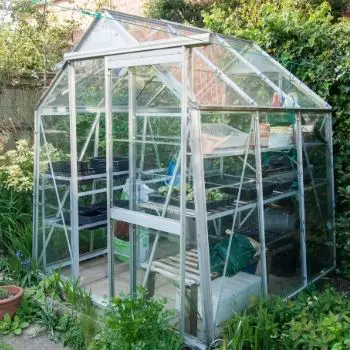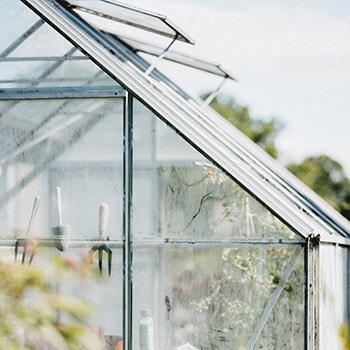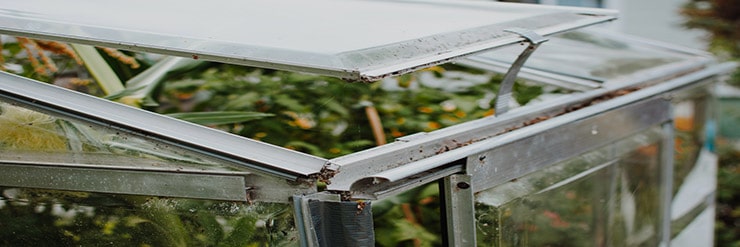A greenhouse is a great way to extend your growing season, but do you need to worry about ventilation? It’s important to create a space that is comfortable for your plants, but you also don’t want to spend a lot of money on unnecessary features. but what about a ventilation system? Do greenhouses need ventilation and if so, how much?
A greenhouse needs ventilation in order to keep the plants inside healthy. In the summer, it’s important to vent the greenhouse to remove excess humidity and heat. In the winter, you will need to vent less often. Ventilation can be achieved as easily as opening a door or window to allow fresh air in.
In this post, we’ll take a look at some of the things you need to think about when it comes to ventilation in greenhouses. We’ll also provide some tips on how you can get the most out of your greenhouse without breaking the bank and the ideal conditions needed for growing in your greenhouse. Keep reading to learn al you need to know about venting a greenhouse
- Do Greenhouses Need Ventilation
- Ideal greenhouse temperature and humidity
- Do greenhouses need to be airtight
- How often should you vent a greenhouse
- Should you leave the greenhouse door open for ventilation
- Should I leave my greenhouse door open at night
- Why Ventilation a Greenhouse
- The main types of greenhouse ventilation
- Conclusion
Do Greenhouses Need Ventilation
One of the most important things to consider when setting up a greenhouse is ventilation. Greenhouses need ventilation to regulate temperature and humidity levels, as well as to prevent problems like mold and mildew from developing. Proper ventilation also helps to keep plants healthy by providing them with the fresh air they need to grow.

There are a few different ways to ventilate a greenhouse. The most common method is to use exhaust fans, which pull hot air out of the greenhouse and help to keep the temperature down. Another option is to use louvered vents, which can be opened and closed as needed to control the amount of airflow.
Whichever method you choose, it’s important to make sure that your greenhouse is properly ventilated. Otherwise, you risk problems with your plants and with the overall health of your greenhouse.
Ideal greenhouse temperature and humidity
As a general rule during summer, A greenhouse should be kept between 75 and 85 degrees Fahrenheit during the day and 60-76 degrees Fahrenheit at night.
While in winter the temperature during the day should be 65-70° Fahrenheit and 45° Fahrenheit at night.

The best way you can control the temperature in a greenhouse is through ventilation or by using a shade cloth. Adding a heating source can be used to increase the temperature if needed.
When temperatures are above about 90°F (32°C) in a greenhouse it can cause damage to some plants.
You will also want to maintain humidity levels within the greenhouse during summer around 60-80 percent.
It’s best to monitor the temperature and humidity levels by using a greenhouse thermometer.
All the temperature and humidity ranges are dependent on what you are growing, for example, tomatoes will need higher levels for growing than those that are needed for growing carrots. Its extremely important to understand the temperature and humidity levels of what you are growing.
Do greenhouses need to be airtight
Airtightness is not a requirement for greenhouses, but it can be beneficial in some cases. Airtight greenhouses can help to regulate temperature and humidity levels, which can be useful in areas with extreme weather conditions.
They can also help to reduce the number of pests and diseases that enter the greenhouse, as well as the spread of these problems to other plants.
However, airtight greenhouses can be more expensive to construct and maintain, and the lack of fresh air can cause problems for some plant species. That’s why it’s recommended to have some form of ventilation in an airtight greenhouse, whether that’s a small opening at the top or sides or a fan that circulates air.
How often should you vent a greenhouse
It is important to vent a greenhouse on a regular basis, especially in the summer months when temperatures can rise quickly. The frequency of venting will depend on the size and type of greenhouse, as well as the local climate.
In general, it is best to vent the greenhouse at least once a day during hot weather.
You will want to vent a greenhouse is to remove excess humidity and allow cooler air to circulate. This will help to keep plants healthy and prevent them from overheating.
If you live in an area with very hot summers, you may need to vent your greenhouse several times a day, you could try 20 minutes of ventilation per time and assess the humidity levels.
In the winter, you will likely need to vent less often, as the goal is to keep the greenhouse warm.
Venting a greenhouse is simply opening the door or windows to let fresh air in and circulate.
You can also use a greenhouse louver vent or fan to help circulate the air. Just be sure not to point the fan directly at plants, as this can cause them to dry out.
If you wanted to spend a little less time moderating your greenhouse, then there are automatic ventilation systems that control the humidity and temperature for you.
Should you leave the greenhouse door open for ventilation

The short answer is yes, you should leave your greenhouse door open for ventilation, especially if your greenhouse doesn’t have an automated ventilation system.
Greenhouses can get very hot, especially in the summer months, and proper ventilation is crucial to keeping your plants healthy.
By opening the door or window, you allow fresh air to circulate and help keep the temperature inside the greenhouse from getting too high. Additionally, good ventilation helps prevent mold and mildew from forming, which can be detrimental to your plants.
Should I leave my greenhouse door open at night
There isn’t a definitive answer to this question since it depends on a number of factors, such as the temperature outside and the type of plants you’re growing. However, in general, it’s best to keep the door open during the day so that your plants can get plenty of sunlight and fresh air. At night, you can close the door to help retain heat.
If you’re worried about insects getting in, you can install a screen or netting over the opening.
Many people do leave a door or window open overnight to help with air circulation. This is often done with a fan to help circulate the air. If you live in an area with high humidity, good air circulation is important to prevent mold and mildew from forming.
If you live in an area where the early mornings are blazing hot then perhaps leving some ventilation might not be a bad idea.
You might want to be careful leaving a door open during the night otherwise you might get a visit from the local cat or other animals. If you want to leave something open during the night, consider a window with an insect netting.
Why Ventilation a Greenhouse
You may be wondering why ventilation is so important for your plants’ success and this is actually for a variety of distractions
Controls Temperature
Everyone knows that plants need heat in the colder months. But did you realize too much heat can actually cause damage to your plants? Having ventilation allows excess heat to escape your greenhouse which in turn keeps your plants from damage caused by excessive heat.
Humidity
Just as the temperature in a greenhouse is critical, so is the humidity levels. Although you need some humidity for the plants to be able to survive, too much can build up and cause problems such as mold and mildew. When you have proper ventilation in your greenhouse, this solves any humidity build-up issues.
Carbon Dioxide
Plants need carbon dioxide to flourish and complete their photosynthesis process. If you aren’t providing artificial carbon dioxide for your plants, the only way they can get this is through proper ventilation. If you don’t have proper ventilation, this is the equivalent of depriving someone of air, your plants won’t grow because they will not be able to breathe.
Pests
In a greenhouse, pests can be a common worry as they can easily cause problems such as eating your plans and becoming a nuisance. Common greenhouse pests include aphids, gnats, shore flies, bloodworms, mites, slugs, and snails. If your greenhouse is too humid and warm, this creates a breeding ground for all of these creatures and your pest problem will multiply. When the temperature and humidity in a greenhouse are kept down with ventilation, this will help you control the pests as well.
Pollination
Unless your greenhouse has a beehive (Which is unlikely) you need to find a way to artificially simulate pollination so your plants can grow. And this can easily be done with a proper ventilation system which includes fans to blow pollen from one plant to the next. If you think you may have a pollination problem in your greenhouse but you aren’t sure, check how well your plants are bearing fruits. If there are no fruits, you have a pollination problem and ventilation may be the culprit.
The main types of greenhouse ventilation
The main types of greenhouse ventilation are natural, forced, and mechanical ventilation.
Natural ventilation is the most common type of greenhouse ventilation and relies on wind to move air through the structure.

Forced ventilation uses fans to move air through the greenhouse and is typically used in conjunction with natural ventilation. Does a greenhouse need a fan? No, it doesn’t, as we explained there are other ways to achieve good ventilation, using a fan is just one of the ways.
Mechanical ventilation involves the use of mechanical devices, such as vents, to control the movement of air through the greenhouse.
There are a variety of factors that should be considered when choosing the type of ventilation for a greenhouse, including the size of the structure, the climate, and the type of plants that will be grown.
The most important factor in choosing the type of ventilation is the climate. Greenhouses in hot, humid climates will require more ventilation than those in cooler, drier climates.
Conclusion
So, do greenhouses need ventilation? Proper ventilation is one of the most critical parts of operating a greenhouse. Without proper ventilation, your plants may get too hot, overrun by pests, or may not get enough carbon dioxide. The type of ventilation system you need to install varies widely on the climate of where you live, as well as the type of greenhouse you own. But no matter which system you pick, having a ventilation system is one of the best things you can do for your greenhouse plants.









